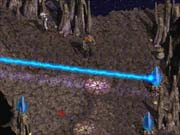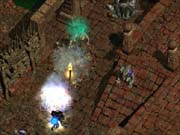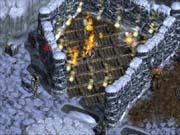The shadow of Diablo looms large over the gaming landscape. Thanks to the phenomenal success of Blizzard's action-RPG franchise, more than a few games have borne its influence. Nox, Revenant, Darkstone, and Throne of Darkness, to name a few, seem to have borrowed from Diablo's isometric action-gaming formula, with its hordes of enemies and hypnotic mouse-clicking. Zax: The Alien Hunter, an action-adventure game from the aptly named Reflexive Entertainment, isn't shy about its influences. The developer trumpets Zax as a combination of Diablo and id's Quake, though Zax has little in common with the latter besides lots of shooting. Zax takes the basic action-packed gameplay of Diablo, puts it in a science-fiction setting, and comes up with a derivative but entertaining game.

Zax features a rather flimsy story, but it still provides a sturdy enough framework to hang the game's action on. The eponymous hero is out scouring the galaxy for profits when he's forced to crash-land on a remote planet. There he meets the primitive korbo, a dinosaur-headed agrarian species that lives in fear of an angry god, OM. OM, you learn, is really a powerful robot with a short temper and a legion of robotic minions. When Zax meets up with the korbo, he naturally discovers his do-gooder side and takes up the fight to liberate them from OM. It's a cliché-ridden plot that sounds a lot like one of the episodes from the original Star Trek TV series. The bland and sometimes childish dialogue doesn't help the story, and the attempts to make Zax sound like a cross between Han Solo and Duke Nukem usually fall flat, too. Lame one-liners like "I'm the man!" just don't cut it, though Zax will utter a few funny retorts from time to time.
Like the story, Zax's gameplay is simple, if not simplistic: You run around and kill stuff. And then run around and kill more stuff. It's a classic gaming formula that can come across as vapid and boring or refreshingly fun. Thanks to Zax's excellent pacing and rewarding action, it's usually the latter here. You'll make your way through 2D prerendered landscapes, exploring lush jungles, alien temples, and innumerable twisting tunnel complexes. Along the way, you'll engage in a never-ending series of key hunts and lever-pulling exercises, with the occasional boss battle thrown in for good measure. Despite their different particulars, the level designs and goals feel very repetitive: You'll free yet another hapless korbo prisoner, switch on the power for some doohickey, or find more artifact pieces for some forgettable reason. That sort of repetition rarely becomes the problem it would be in other games: The level goals and layouts are really just there to funnel more monsters your way, arcade style. There's just enough diversity to hold your interest and keep the action flowing.

During your adventures, you'll face a range of death-dealing robots and native animals, like grunting warthog-like creatures that charge out of the underbrush at you. Similar to the classic arcade game Gauntlet, many of the robots continually spawn from monster generator pads until you destroy a nearby control panel. To fight the game's menaces, you'll employ weapons such as a modified laser welder, an automatic pistol, a sentry gun, a grenade launcher, and a missile launcher. Many of the weapons are superfluous since you can easily play through the game using just a handful of them. Weapon choice is more of a personal preference than anything. When using your guns, you'll find that the controls can feel a bit awkward at first but work very well with practice. You move Zax with the keyboard and move his targeting cursor independently with the mouse. The cursor doesn't show the exact spot where a weapon will hit, but rather the direction in which it will fire. These controls make Zax feel a bit like another '80s arcade classic, Robotron: 2084.
You'll learn about your weapons from Zelon, the female-voiced computer on Zax's ship. Zelon, affectionately known as Babe, relays story-based mission objectives, advice, and explanations. Babe might seem a bit too talkative for your taste, though. Her dialogue box will appear so frequently during a few of the early levels as to be distracting, sometimes even popping up during the middle of firefights thanks to scripted events.

Scripted events can interfere with gameplay in other ways too. You might run across a robot and find that you can't shoot at him until he's uttered a bit of dialogue first. That sort of awkwardness isn't uncommon in Zax. When OM was programming his robotic henchmen, he apparently forgot to finish their artificial intelligence. Despite a nearby battle, enemies seem to react only if you walk right next to them or activate hidden triggers in certain areas of the maps. Happily, believability isn't really important in an arcade-style action game like this. To compete against brighter opponents, you can play Zax online in three multiplayer modes: salvage king, deathmatch, and capture the flag. Trying to access multiplayer through a firewall can result in system lockups, though. In fact, a number of bugs, like one that drops you to the Windows desktop when you try to restart a mission, mar the game.
As you tackle Zax's hundred or so relatively small maps, you'll grab a variety of power-ups, often found hidden in ceramic pots or bamboo boxes that litter the landscape. Ore and crystals can be taken back to Zax's stranded ship, where they're transmuted into weapons and other gadgets by a materials generator. A native fruit can heal Zax's wounds. Floating spheres of energy left by destroyed robots recharge Zax's shields and some of his guns. More notable than the items you do find are the ones you won't: Other than an alien gun, there aren't any random items that boost your powers or abilities. Access to new weapons at your ship only seems to progress on a hidden timetable. Also, there are no character classes to choose and no skills to build up; you just play as the default character. While Zax does offer three difficulty levels, the single-player game is only around eight to 12 hours long. So, without those other features, replay value suffers. That's a lesson that Reflexive apparently didn't learn from Diablo.

Zax's visuals could certainly give the Diablo series a run for its money, though. The beautiful graphics show just how much life is left in 2D gaming: While the landscapes and creatures aren't particularly imaginative, they're crisp and colorful, and they show a really fine attention to detail. You can almost feel the dirt and jagged rocks near Zax's ship or the thatched roofs of a korbo village. Weapons, teleporters, and other high-tech gadgetry give off sparking and sparkling light shows. The designers rely on the game's isometric perspective for some cheap tricks, though, hiding robots and sentry turrets where you literally can't see them until it's too late. Vivid sound effects complement the vibrant visuals well. Other than the classy Zelon, the voice-overs and ambient elevator music are forgettable, though.
On paper, Zax: The Alien Hunter sounds like another Diablo wannabe, and in some ways it is. Other than really fine 2D graphics and lots of action, it theoretically doesn't have too much going for it: The story is weak, there's no real character building, you'll encounter few particularly interesting monsters or weapons, and you won't find much replay value. But in practice, Zax succeeds admirably with its simple aims. It handles one vital game design element extremely well: pacing. The speed of the battles, the intervals between enemy encounters, the time it takes to solve puzzles, and the balance between exploring and fighting are all deftly handled. If only more games could succeed as well in that regard. Ultimately, Zax is simple and repetitive in the same way that simple and repetitive arcade games of the past offered action-packed, addictive entertainment.



